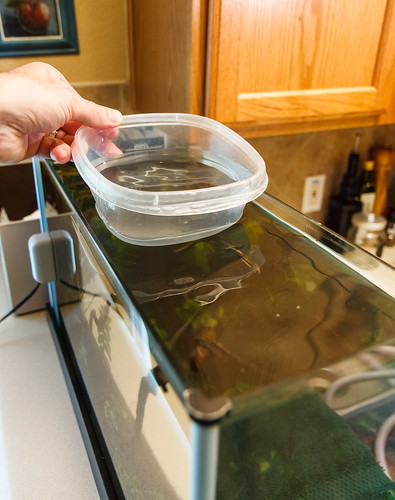When I was gathering various tubs and containers to use in my aquarium maintenance, I wondered what plastic containers would be suitable and safe to use. I didn’t want a plastic container that would leach harmful chemicals into the water I was transferring.
The answer is simple and relates to those little recycle symbols on the bottom of plastic containers.
Decoding the Recycle Symbol for Aquarium Safe Plastics:
A plastic that is aquarium-safe will also be food-safe. This is to say, the best containers to safely store foods are the best to use for your aquarium maintenance needs.
The little recycle symbol (three arrows formed into a triangle with a number in the center) helps recycle centers to identify resin plastics of like kind. The best type of plastic for use with foods have the number 2 in the center. These are plastics made of high-density polyethylene (HDPE). Compared to other types of plastics that are categorized (numbers 1 through 7), HDPE is relatively stable and inert. This means that it doesn’t leach chemicals into food or fluids over time. This makes HDPE plastics with the #2 recycle symbol aquarium safe. From what I see, #2 plastics tend to be used for items with more strength and stiffness.
A close second to #2 plastics are #4 and #5 plastics. #4 plastics are Low-Density Polyethylene, or LDPE. #5 plastics are Polypropylene. Polypropylene plastics have a high tolerance to heat, so many microwavable containers are made of polypropylene.
The only food-grade plastic I would avoid for aquarium use are #1 plastics. These are PETE or PET plastics, often used for one-time items like plastic water bottles. These plastics are slightly more unstable and can readily leach chemicals if used over time.
I’d prefer seeing the #2 or #5 symbols for items I was using for an aquarium. My large Home Depot bucket is a #2 plastic. The remainder of the small Rubbermaid or Tupperware containers that I use with the aquarium are #5 Polypropylene.
Best Practices for Cleaning Aquarium Plastics:
I want to mention that beyond the type of plastic you use for aquarium maintenance, it’s important not to contaminate aquarium containers with soap.
I never use any soap on my aquarium buckets and maintenance Tupperware. Even new items purchased from the store, I only rinse with water to get them clean. If you use soap, you risk contaminating your tank – soap and your fish/inverts do not mix.
Even the best aquarium-safe plastics can be ruined if you wash them with soaps, so avoid that temptation – only rinse with water.





Hi, can I use plastic ornaments from the dollar store to decorate my aquarium?
Not likely. You have to know what kind of plastic you’re dealing with, as stated in the article. Here’s another article with more information… https://www.ecowatch.com/7-types-of-plastic-wreaking-havoc-on-our-health-1882198584.html
From what I’ve gathered in an article written around 2 years after this one, #2 is more likely to leach estrogenic chemicals than #5, as is #4, so I would’ve listed #5 as the best option out there.
Thanks for the link. I’ll have to put some thought into this. Certainly estrogenic chemicals pose health concerns for human consumption – not sure how these concerns rank when compared to the top needs of aquarist.
I am moving house and want to take my goldfish with me that at the m oment are in a large pond…
they need to stay in a large container whilst a pond is being built…which could take a month say.
Can I use a plastic dustbin which will give them depth and keep them safe?
The type of container isn’t your main concern in this scenario. For a move, make sure the container is structurally sound to hold the weight of the water.